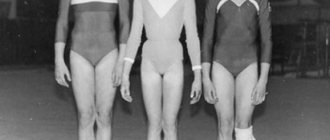Salvador Dali and Gala - a story of unusual love
Read the beginning of the story in the previous article “A Woman Born for a Genius”
She understood men, loved sex and was a liberated, calmly confident woman. Dali was not like everyone else in his intimate life, but Gala, understanding his desires and nature, entered this world, where he felt like a real man with her, not leaving him even a corner of his own soul, wherever it was not.
Determined to make Dali a famous artist, Gala made every effort to ensure that people heard about him. She used all her connections, organized all kinds of exhibitions with Dali’s works, sometimes took his works and went with them to various connoisseurs of modern art, and soon her efforts were crowned with success and the whole world heard about the surrealist artist.
Temptation of Saint Anthony, 1946
At this time, Gala’s husband still continued to hope that she would return to him and again become a source of his inspiration, as she had been before.
He wrote love letters to her, but received no response to any of them, then he began to drink a lot and completely lost the ability to create. Out of pity for him, or maybe for some other reason, Gala did not divorce her poet husband and accepted Dali’s proposal only after Eluard’s death in 1934.
The Dali couple settled in Paris, where Gala, having left her husband and daughter, began the main work of her life, “creating the Dali brand.” She did everything to inspire her genius. She was the living embodiment of passion, maternal care and sincere friendship. Dali felt protected with her, he could create, and she, his Gala, took care of the rest.
What a successful union, the genius of the artist Dali and the pragmatism of Gala, who not only skillfully managed her husband’s creative career, but also constantly inspired him, being his muse. She always told Dali: “You are a genius, and that is undeniable!” - and soon Dali really believed in his genius.
Dali paints extraordinary paintings one after another, and signs them with the double name “Gala-Salvador Dali”. Gala did everything to show Salvador's paintings to everyone who could appreciate and buy them, from her rich friends, among whom were Diaghilev, Stravinsky, Aragon, Disney, Hitchcock, to the owners of art galleries. She protected her husband from everything that could interfere with his painting, and did not allow people to see him when he was working or thinking about a new painting. Having shouldered everyday life and production responsibilities, she created all the conditions so that nothing would distract Dali from the creative process.
Now the whole world has heard about Dali’s paintings, and people have been gossiping about the family life of the unusual couple. Some called them rich perverts, others schizophrenics, which was not strange, because they never ceased to shock the public with their eccentric antics.
They had nothing to do with gossip and condemnation. Dali constantly draws his wife, in different images, Helen the Beautiful, the Mother of God, the Woman with Chops on her Back, etc. Gradually, interest in Dali's paintings began to fade and the prudent Gala gave him the idea of creating designer items that are successfully sold among the rich all over the world.
Among such things are sofas in the shape of women's lips, strange watches with a bizarre dial, elephants on thin legs and other embodiments of the artist's fantasies. Dali became bolder; there was no longer any need to instill confidence in his genius. As they say now, it was practically a star fever, at the moment of “exacerbation” of which, he even quarreled with his close friend Breton and other surrealists, once declaring: “Surrealism is me!”
Gala and Dali often began to spend time separately from each other; she did not get tired of changing lovers, who were one younger than the other. Dali spent his time surrounded by young beauties, organizing crazy orgies, where he acted as an observer and spent a huge amount of money on his entertainment. In 1965, Dali met 19-year-old Amanda Lear, then a model, singer and artist known as Peki D'Oslo, at the Castel restaurant, who would be his friend and muse for 16 years. They say Amanda Lear is a play on the words L'Amant Dal, which means Dalí's mistress in French.
Dali’s first compliment to the young beauty was the words: “You have a beautiful skull and a high-quality skeleton.”
Amanda is considered Dali's second muse, but the only woman who could influence Dali was always Gala. Amanda Lear herself, recalling her acquaintance with Gala, said that Dali, before introducing her to his wife, was nervous and seemed to be afraid that she would not like her. When Dali introduced the two women to each other, Gala looked at Amanda with narrowed eyes, examining the makeup of the girl who loved glitter and bright lipstick, and said, “Oh God, what is this?!”
A relationship where a man introduces his wife and his mistress, while expecting approval from the first, may seem strange, but in the couple Dali and Gala, strangeness was common. Despite the fact that initially Gala showed strong dissatisfaction with the appearance of Amanda in Dali’s life, cut out her face from photographs in magazines, and hurled harsh remarks at her¸ after some time, the three of them were often seen together, while attending social parties and other events.
Gala realized how good Dali was with his new Muse, and this was probably her genius. She mentored Amanda and entrusted her with taking care of Dali, and even sponsored the girl. Once Gala asked Amanda to give her word that she would marry Dali after her death. But by the time Gala passed away, Amanda had forgotten about her promises, being busy with her career and by that time already having a stamp in her passport.
In 1968, Dali gave his divine woman Gala, as he always called her, a medieval castle in Pubol, which was built in the 11th century. He once promised to give her a castle and fulfilled this promise. Dali himself could attend the Gala in Pubol only at her personal invitation.
Through a table on the second floor, Gala could admire the white horse that stood on the first floor.
Designer Gala outfits.
Gala was very afraid of old age, like probably every woman, especially one who was used to shining and conquering. She spent a huge amount of money on plastic surgery and young lovers; Dali himself was no longer interested in her.
She organized orgies in her castle, invited young men who entertained her by playing the piano, dancing and mercilessly robbing her. She constantly needed Dali’s money, and she repeatedly told Amanda Lear that she would better stimulate the artist to create.
Jeff Fenholt and Gala
She devoted her whole life to Dali, all he wanted was to be the center of the universe. Now she wanted to live for herself. Her last crush was the young singer Jeff Fenholt.
In 1980, Dali was admitted to a clinic in Barcelona. Dr. Pigwert considers his condition very serious, and his mental health was especially worrying. Returning home after the clinic, Dali painted the darkest painting “Extramined Angels” that he had ever created.
Gala, as before, was next to her Dali; even during the most severe attacks of depression, he needed her presence. She was forced to abandon Jeff and devote all her time to Dali. Having said goodbye to the last fragment of the illusion of her youth, the old woman becomes angry with her husband and periodically falls into fits of rage. Jean-François Vogel, a journalist who was well acquainted with the Dali couple, said: “Dali was very harsh and harsh with Gala. He always did what he wanted, not what she wanted.”
On January 26, 1981, the magazine “Ell” published an article in which Dr. Rumeger, Dali’s first psychoanalyst, gave an interview: “The truth is that Dali has lost the will to live. What is happening now is suicide simply because Gala no longer cares about him. She is eighty-six years old. Her mind is clear no more than two or three hours a day; She devotes all this time to thoughts about Jeff... whom she also calls Salvador... She scolds Dali and scolds him as best she can. Thus, the whole world around Dali collapses. You have, of course, heard of babies separated from their mothers because of war or serious illness, who die of despair. The same thing happens with Dali.”
In the relationship between Dali and Gala, the tenderness that once brought them so much pleasure is now rare; the old spouses now and then attack each other with their fists. In 1982, Gala did not step well and fell, breaking her femur, and was taken to the hospital in severe pain. Due to many plastic surgeries, a woman’s skin cracks and multiple wounds form. She slowly falls into agony, occasionally in moments of clarity, inquiring about Dali.
Unable to see his Gala turn into a piece of meat, he visits her only once in the hospital. The rest of the time he waited for her return. She was brought home in April. Gala no longer looks like herself, she can hardly speak. The sisters of mercy look after her, wash her, comb her hair, turn her over, and try to ease the suffering of a dying woman. Dali placed Gala's bed so that she could see the sea. At night he comes to her room and lies down on the next bed to be close to his dying wife. He ordered a screen to be installed between the beds, as he experienced great agony when he looked at what his beautiful Galuchka had become.
On the afternoon of June 10, Dali cried out in a drawn-out voice. The alarm was raised. Gala looked out the window with frozen eyes: she died.
Dali buried his wife in Pubol Castle, in a crypt that she herself had built during her lifetime, and where two places were prepared for her and her Dali. Due to the ban on the export of the body of a very ancient Spanish law, in force since the time of the plague, Dali decides to break it for the sake of Gala and, wrapping her body in a blanket, transports her to Pubol Castle in the limousine in which they once traveled, young and happy. Italy and France, so the family limousine turned into a hearse.
Gal's embalmed body was dressed in a red dress and buried in a coffin with a glass lid in a narrow circle of only the closest people. Dalí survived his Gala by seven years, which he spent in seclusion in the castle in Pubol, where the woman of his life lay under a glass lid. Gal's death seemed to return him to an embryonic state; he stopped speaking and practically did not move.
The amazing relationship between Dali and Gala lasted 53 years. The extraordinary talent of the artist Dali and the amazing character, the unusual nature of Gala’s female nature, representing a successful symbiosis of two people, turned out to be a resounding success.
Perhaps the most extraordinary couple of their time became an example of how two wild and extraordinary natures can coexist for more than half a century, remaining devoted to each other in the special sense of the word. Was Gala a femme fatale? I think so. But this is not the most unusual thing about her; she, wanting to be a muse, practically a work of art for her husband, herself became the creator of his talent.
This woman inspired self-confidence in the insecure artist, revealed the scale of his talent and was his reliable companion all his life, protecting and preserving him.
A woman who knew some special secret, who managed to become not only the muse of a genius whom he worshiped.
Until her old age, Gala did not lose her passion for life, wanting to burn as long as possible and as brightly as possible. Who knows, but maybe if Gala and young Dali had not met, the world would never have recognized the great artist Salvador Dali.
Who is Gala?
Gala, with the emphasis on the last letter, as in all French words, her real name is Elena Ivanovna Dyakonova. She was born in 1894, in Kazan, into a poor family. Her father was a minor official who died when the girl was still very young. Mother married a lawyer for the second time. When Elena was 17 years old, the family moved to Moscow. There the girl became a high school student; by the way, she studied together with the future poetess Marina Tsvetaeva.
Gala
At the end of life
In 1982, as a result of a fall, Gala broke her hip. She was placed in a hospital, where her mind gradually abandoned her. The artist's muse died alone, forgotten by her many lovers, on whom she so carefreely and generously spent money.
Dali, having learned about this, went against the law (in those days it was impossible to independently transport the bodies of the dead) - he put Gala in her favorite dress, large sunglasses, sat her in a Cadillac and took her to the castle in Pubol, where his muse and was buried.

Salvador Dali
Gala and Paul Eluard: the poet's muse
Elena had very poor health since childhood, and at the age of 18 she was diagnosed with tuberculosis. The girl is sent to Switzerland for treatment, where in a sanatorium there was a fatal acquaintance with the poet from France Eugene-Emile-Paul-Grendel, this is the future Paul Eluard. Paul's parents sent him there to be treated for a strange disease - poetry.
And then it began: a passionate romance broke out between them.
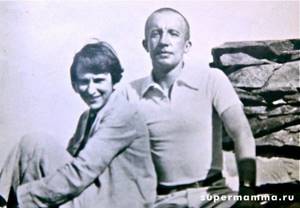
Gala and Paul Eluard
The poet’s father and mother were against it, trying their best to dissuade Paul from any connection with the “Russian girl.” But it was no use. The flame had already flared up, despite the fact that the lovers had to part for a while, they constantly sent each other letters. Even then, in the letters, a bright maternal principle can be traced in Elena (it was during this period that she decided to rename herself Gala, which means “holiday”, “fun”). She often refers to the field as “boy”, “darling”.
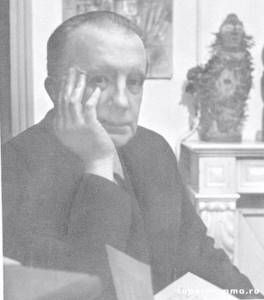
Paul Eluard
Gala phenomenon
“Galatea”, “my talisman”, “my treasure”, “my little treasure” - this is how Dali wrote about his wife. Her image can be found in many paintings, even in the face of the Mother of God. The artist has said more than once that he loves her more than anything in the world - more than money, fame, even more than his mother. Or rather, instead of a mother. The artist lost his mother early, and Gala managed to give him maternal care and love, which the man so badly lacked.
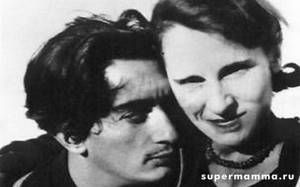
Gala and Salvador Dali
Those close to the couple, in particular, Gala’s sister, having come to visit them, more than once spoke about Gala’s motherly behavior towards Salvador: she cleaned up after him, brought him drinks and food, deified him, and took care of him in every possible way.
Salvador Dali and Gala
And in response, the artist created: he signed the paintings: “Gala-Salvador-Dali.” In fact, Gala created the Salvador Dali brand with her own hands and was not only its muse, but also a skillful manager and financier. She managed to convince Dali of his exclusivity, uniqueness and genius, and the artist, in response, was ready to present Gala with the whole world.
Salvador Dali and Gala
The childhood of Salvador Dali
Salvador Dali was born in 1904 in the city of Figueres, Spain. His father was an atheist notary, and his mother was an ardent supporter of Catholicism. During his school years, his talent as an artist manifested itself in drawings in the margins of his notebooks. Later, the artist Ramon Piho worked with Dali. Part of the boy walked among representatives of the lower strata of society, sailors, fishermen, absorbing the mythology of his people, which was later reflected in his works. At the age of 17, he went to Madrid to study at the Academy of Fine Arts, but fell under the influence of Lorca and Bunuel - ardent opponents of conservative norms and was expelled from the Academy for spreading “rebellious” ideas. Salvador's father was upset: he still flattered himself with hopes that his son would follow the path of a civil servant.
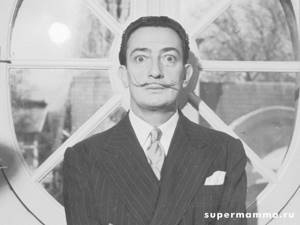
Salvador Dali
So gradually, step by step, under the influence of Nietzsche, Freud, Breton, Joan Miro, Dali offered the world a completely new artistic approach, which he called the “paranoid-critical method.”
Salvador Dali










